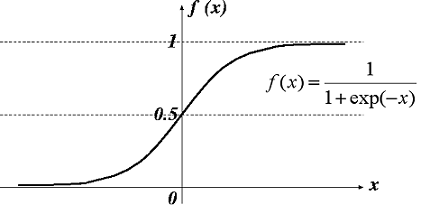はじめに
ロジスティック回帰モデルを使って車の燃費を予測してみました。
学習メモなので基本用語の詳しい解説などは書いていません。
前の記事は以下
前提知識
実装前に必要となる知識をまとめました。
ロジスティック回帰(Logistic Regression)
ロジスティック回帰は、ある事象が起こる確率を予測、分析したい時に用いられる手法です。
分類が曖昧なものを判別したいときに利用され、データが各クラスに所属する確率を計算することで分類を行います。
3種類以上の分類にも利用することができます。
シグモイド関数
年齢によってどんな趣味を好む人が多いかどうかを判定したいケースを考えます。
10, 20歳は「映画」、30, 40, 50歳は「読書」が好みだとして、それぞれの趣味を0と1に数値化すると、Training dataのプロットは線形になりません。
交差エントロピー(Cross Entropy)
交差エントロピーはロジスティック回帰モデルの性能を数値化する手法の一つです。
線形回帰モデルの性能評価で使う平均二乗誤差(MSE)と同じ損失関数と呼ばれます。
式で表すと以下のようになります。
Actualは実測値をエンコードした値、Guessはsigmoid(mx+b)を示しています。

また、交差エントリーの微分は以下のように表すことができます。
weightsはm, bのテンソルになります。

実装
ロジスティック回帰モデルのクラスをつくるにあたり、線形回帰モデルのクラスをリファクタリングしました。
メソッドの構成
線形回帰モデルのクラスとメソッドの構成はほぼ同じですが、MSEではなくCross Entropyを算出するため、処理の内容が若干異なります。
コード
コードは以下です。
const tf = require('@tensorflow/tfjs');
const _ = require('lodash');
class LogisticRegression {
constructor(features, labels, options) {
this.features = this.processFeatures(features);
this.labels = tf.tensor(labels);
this.costHistory = [];
this.options = Object.assign(
{ learningRate: 0.1, iterations: 100, decisionBoundary: 0.5 },
options
);
this.weights = tf.zeros([this.features.shape[1], 1]); //m, bの初期値
}
gradientDescent(features, labels) {
const currentGuesses = features.matMul(this.weights).sigmoid();
const differences = currentGuesses.sub(labels);
const slopes = features
.transpose()
.matMul(differences)
.div(features.shape[0]); //列の個数で割る
this.weights = this.weights.sub(slopes.mul(this.options.learningRate));
}
train() {
const batchQuantity = Math.floor(
this.features.shape[0] / this.options.batchSize
); //バッチの回数
for (let i = 0; i < this.options.iterations; i++) {
for (let j = 0; j < batchQuantity; j++) {
const startIndex = j * this.options.batchSize;
const { batchSize } = this.options;
const featureSlice = this.features.slice(
[startIndex, 0],
[batchSize, -1]
);
const labelSlice = this.labels.slice([startIndex, 0], [batchSize, -1]);
this.gradientDescent(featureSlice, labelSlice);
}
this.recordCost();
this.updateLearningRate();
}
}
predict(observations) {
return this.processFeatures(observations)
.matMul(this.weights)
.sigmoid()
.greater(this.options.decisionBoundary) //指定値以上なら1
.cast('float32');
}
//決定係数を出す
test(testFeatures, testLabels) {
const predictions = this.predict(testFeatures); //0.5以上は1にする
testLabels = tf.tensor(testLabels);
const incorrect = predictions.sub(testLabels).abs().sum().get(); //predictと一致しないカラムの数の合計
return (predictions.shape[0] - incorrect) / predictions.shape[0]; //予想と一致した割合
}
processFeatures(features) {
features = tf.tensor(features);
features = tf.ones([features.shape[0], 1]).concat(features, 1);
if (this.mean && this.variance) {
features = features.sub(this.mean).div(this.variance.pow(0.5));
} else {
features = this.standardize(features);
}
return features;
}
standardize(features) {
const { mean, variance } = tf.moments(features, 0);
this.mean = mean;
this.variance = variance;
return features.sub(mean).div(variance.pow(0.5));
}
//Learning Rate調整のためにCostを記録する
recordCost() {
const guesses = this.features.matMul(this.weights).sigmoid();
const termOne = this.labels.transpose().matMul(guesses.log());
const termTwo = this.labels
.mul(-1)
.add(1)
.transpose()
.matMul(guesses.mul(-1).add(1).log());
const cost = termOne
.add(termTwo)
.div(this.features.shape[0])
.mul(-1)
.get(0, 0);
this.costHistory.unshift(cost);
}
//Learnin Rateの更新
updateLearningRate() {
if (this.costHistory.length < 2) {
return;
}
if (this.costHistory[0] > this.costHistory[1]) {
this.options.learningRate /= 2;
} else {
this.options.learningRate *= 1.05;
}
}
}
module.exports = LogisticRegression;
予測値の算出
入力値と算出したweights(m, b)をシグモイド関数に当てはめた結果が、入力したしきい値より大きければ1、小さければ0とします。
ロジスティック回帰における予測値はこのように算出されます。
predict(observations) {
return this.processFeatures(observations)
.matMul(this.weights)
.sigmoid()
.greater(this.options.decisionBoundary) //指定値以上なら1
.cast('float32');
}
おわりに
3記事書いたことで学習内容を整理することができました。
今後の学習の指針については、AIに詳しい人にきいて考えてみようと思います。
参考資料
